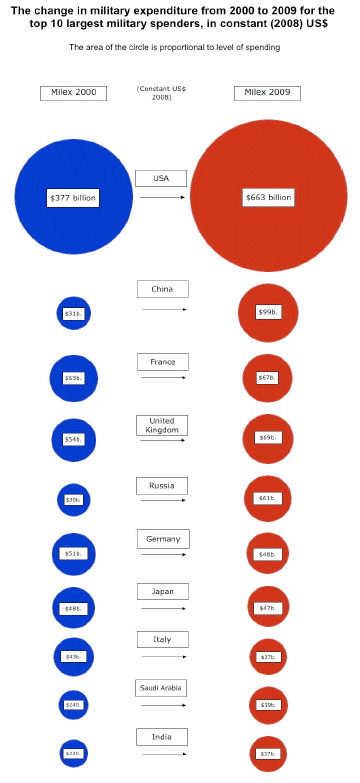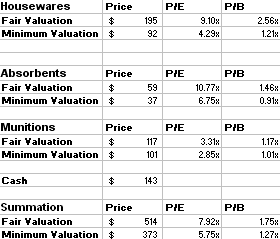In recent weeks, we introduced readers to the National Presto business, and then dug into the housewares segment and the absorbents business. This week we’ll look at the munitions business.
Munitions
The final piece of the puzzle is the munitions business. Over the past few years, NPK has acquired a number of military contractors; AMTEC in 2001, Spectra Technologies in 2003, and Amron in 2006. And as US military operations have grown, so has revenue and earnings. In particular, NPK manufactures 40mm (millimeter, not million) ammunition, grenades launched from a canister attached to an M16. Military use of this weapon system increased significantly over the past decade. Every year the DoD releases budget estimates including the past year’s expenditure and estimates for the coming two years. In 2000, the DoD spent $44 million on 40mm ammunition, compared to $318 million in 2009. Estimates for 2010 and 2011 expenditures are $176 and $230 respectively. Looking back over the past decade, we see these estimates are prone to change, but it’s still our best guide. The table below shows actual military procurement in yellow followed by two years of forecasts. At the bottom, we compare procurement to NPK sales.
The munitions piece of the puzzle is really where we need to make assumptions. The problem is that the DoD has been building an inventory of ammunition for the past few years. The US isn’t consuming all it buys. As we scale back operations, not only will we use less ammunition (both in training and in the field), but we will require lower reserves. Even if 40mm ammunition grows in importance, procurement is going to slow down. And the sustainability of our operations is a major factor. The Stockholm International Peace Research Institute published these numbers recently, showing how much our operations have grown and how much we spend compared to the rest of the world:
Although first quarter NPK sales trended down this year, possibly confirming our expectations, the backlog at the end of 2009 was the largest ever at $274mm, implying $69mm of sales per quarter. This would mark a slight improvement over 2009 and the first quarter of 2010. Supply contracts also indicate at least $33mm of munitions sales in 2011 and $99 in 2012, with munitions generally representing 50% of sales and a decent chance of a supplemental award boosting 2011 sales (these awards seem to come in September). So I think a fair assumption is $274mm of sales in 2010, and then $200 in both 2011 and 2012. At a 20% margin, consistent with historical financials, that yields FCF in the range of $35mm in 2010 and $25 in 2011 and 2012. If we assume that sales are reduced by 2/3 to $60mm in perpetuity, the business will continually yield $7.75mm. Discounting the whole thing at 15% yields a present value for the munitions segment of $101mm. If we assume that the first three years of revenue is less risky than the long-term $7.75mm estimate, we might want to discount it at a lower rate. At an 8% discount rate, that raises our present value to $117mm. Obviously there’s a tremendous amount of room for varying estimates, but these are the ones we’re comfortable with.
Putting the three parts of this business together, we can get a range of possible valuations:
Even though these prices are well below the current market value of $660mm, this is by no means a recommendation to short. The company is generating a tremendous amount of free cash flow and paying a dividend. More importantly, our valuation is very conservative. We can easily justify higher valuations (although we wouldn’t pay them). Our main purpose for writing this was to provide ourselves and our readers with a road map to follow if NPK shares continue to fall. But of course the situation will change as time goes on. If NPK is awarded more contracts, if the DoD Comptroller upwardly revises the 40mm ammunition budget (which it has done numerous times in the past), or if we see continued profitability from the other two business segments, we will need to adjust our estimates upwards. However, as the backlog is worked off, we might have to adjust our expectations downward unless new contracts are awarded. At the moment, the housewares and absorbents segments are operating at very high levels of profitability. It benefits us to wait patiently to see how sustainable these operations are.
At the moment, $75/share is a fair entry price. At $55, NPK is a no-brainer. The best scenario is the stock price collapses and the underlying fundamentals continue to improve, firming our confidence in our estimates, and we’re all well prepared to buy. Worst case scenario, we miss out on buying a good company at today’s prices, but without a large enough margin of safety. On that note, I’ll leave readers with a pair of quotes I found in a text book I’ve been casually reading for 2 years, “Business Dynamics: Systems Thinking and Modeling for a Complex World” by John Sterman.
Delay always breeds danger.
-Miguel de Cervantes (Don Quixote, Book iv, Chap.ii.)
Never do today what you can put off till tomorrow. Delay may give clearer light as to what is best to be done.
-Aaron Burr
At the time of this writing, Kerrisdale Capital and it’s affiliates have no position in NPK.
LEGAL:
THIS COMMUNICATION IS FOR INFORMATIONAL AND EDUCATIONAL PURPOSES ONLY AND SHALL NOT BE CONSTRUED TO CONSTITUTE INVESTMENT ADVICE. NOTHING CONTAINED HEREIN SHALL CONSTITUTE A SOLICITATION, RECOMMENDATION OR ENDORSEMENT TO BUY OR SELL ANY SECURITY OR OTHER FINANCIAL INSTRUMENT OR TO BUY ANY INTERESTS IN ANY INVESTMENT FUNDS OR OTHER ACCOUNTS. ACCOUNTS MANAGED BY KERRISDALE CAPITA, THE AUTHOR OR AFFILIATED PARTIES MAY OWN SECURITIES OF OR OTHERWISE HAVE AN INVESTMENT RELATED TO ANY COMPANIES MENTIONED IN THIS POST. WE MAY BUY OR SELL SHARES AT ANY TIME. WE MAY NOT DISCLOSE OUR PURCHASES OR SALES IF AND WHEN WE BUY OR SELL, AND WE WILL NOT NECESSARILY DISCLOSE UPDATED INFORMATION IF WE DISCOVER SOMETHING FAULTY WITH OUR ANALYSIS AT A LATER DATE.THE AUTHOR HAS NO OBLIGATION TO UPDATE THE INFORMATION CONTAINED HEREIN AND MAY MAKE INVESTMENT DECISIONS THAT ARE INCONSISTENT WITH THE VIEWS EXPRESSED IN THIS COMMUNICATION. THE AUTHOR MAKES NO REPRESENTATIONS OR WARRANTIES AS TO THE ACCURACY, COMPLETENESS OR TIMELINESS OF THE INFORMATION, TEXT, GRAPHICS OR OTHER ITEMS CONTAINED IN THIS COMMUNICATION. WE EXPRESSLY DISCLAIM ALL LIABILITY FOR ERRORS OR OMISSIONS IN, OR THE MISUSE OR MISINTERPRETATION OF, ANY INFORMATION CONTAINED IN THIS COMMUNICATION.







